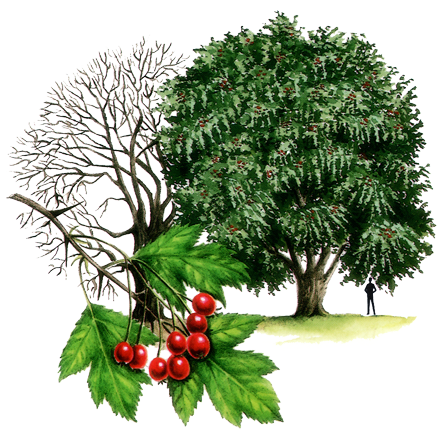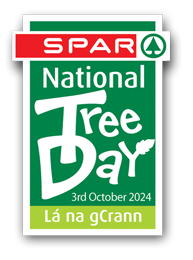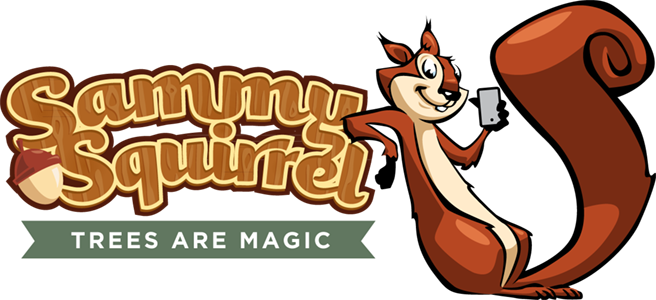Spotlight on The
Native Hawthorn Tree
About the native Hawthorn Tree
An Sceach Geal…
Crataegus monogyna

The theme for SPAR National Tree Day 2024 is ‘Trees are Magic,’ and this year we’re focusing on the magical Hawthorn tree!
The Hawthorn tree, also called Whitethorn or the May Bush, is known in Irish as An Sceach Geal and its Latin name is Crataegus monogyna. It’s a native Irish tree that you can find in many hedgerows and woodlands where the soil is rich and fertile. Occasionally it will grow by itself in a rocky or neglected area in a field where it is known as a “Lone Bush”, usually from a seed dropped by a bird. These trees are very special because they grow from seeds inside their berries, called haws. In the autumn, these bright red berries are a favourite food for birds like thrushes and blackbirds.
Hawthorn trees can grow up to 5 meters tall if they aren’t trimmed. They are deciduous, which means they lose their leaves in autumn. In April, their new leaves appear, which are small, green, and have a unique shape with three or four lobes. Long ago, children used to call these leaves “Bread and Cheese” and would nibble on them on their way to school, even though they don’t taste anything like bread and cheese!


In May, the Hawthorn tree is covered in beautiful white flowers with five petals each. These flowers produce a strong, sweet smell that attracts lots of insects looking for a nice drink of sweet nectar which is in each flower. Bees especially love these flowers because they collect pollen to make honey and feed their young and then nectar, which they will make into honey for the adults to eat. All the buzzing insects help pollinate the flowers, which means they carry pollen from one flower to another, allowing the tree to produce berries.
By the end of May all the flowers are pollinated in this way. Then the white flower petals fall off and the berries – the haws begin to form. These are green at first and only become red in Autumn when they are fully ripe and ready to be eaten by the birds.
The Hawthorn tree has sharp thorns on its twigs and branches, making it perfect for hedges because it helps keep animals in fields from escaping. Its wood is hard and durable, so people used it for tool handles and firewood because it burns very well and gives off lots of heat. Long ago, its leaves were used to dye cloth a dark blue colour, and people made jelly or jam from its berries, along with other fruits like rosehips and blackberries. The haws help the jam set because they become gelatinous when boiled. However, the berries aren’t very sweet, so people only ate them when they had nothing else to eat, leading to the saying, “when all fruit fails, welcome haw.”
In ancient Ireland, the Hawthorn tree was highly valued. According to Brehon Law, there were severe penalties for cutting down someone else’s Hawthorn tree. If a branch was cut off, the penalty was a sheep, and if the tree was removed altogether, the fine was two milk cows. Hawthorn was also the letter H in the Ogham alphabet and represented the month of April/May in the Celtic calendar.
The Hawthorn tree is also magical in Irish mythology – it was considered the fairies’ tree, and people believed it had magical powers. Fairies, known as the Sidhe, were thought to dance around lone Hawthorn trees, and it was considered very bad luck to harm these trees. These fairies are quite different from the ones we think of today. They were originally a tribe called the Tuatha de Danann who lived in Ireland about four thousand years ago. When they were defeated by another group called the Milesians, they moved underground and became known as the Sidhe. They were believed to live in fairy forts and only come out at night to dance and play music, especially around lone Hawthorn trees.



One famous story tells how a “sacred” fairy bush, a Hawthorn tree in County Clare, was saved from being cut down when a new motorway was built in 1999. The engineers changed the road’s path to protect this tree because it was believed to be a meeting place for fairies. It was thought that if humans harmed the tree, the fairies would take revenge. It is also considered very unlucky to bring Hawthorn blossoms into a house.


Hawthorn trees are often found near Holy Wells, decorated with rags and offerings from people seeking cures for ailments. These magical trees support a lot of wildlife, with 149 different insect species living on them. One common insect is the Hawthorn Shield Bug, which feeds mainly on the leaves but doesn’t harm the tree. Planting a Hawthorn tree can bring a little bit of magic and a lot of life to your garden or school, as these trees are perfect for increasing biodiversity with their leaves, flowers, and berries.
When applying for your sapling tree, you need to consider where the tree will live and grow for the rest of its life.

